How to Hanami: Tips for a perfect appreciation of Sakura Bloom

Every year, something truly magical happens in Japan. Families, friends, and colleagues come together for one purpose: Hanami. By learning about Hanami, you can fully appreciate the practice and become an active and valuable participant.
Hanami: The Art of Cherry Blossom Viewing

Hanami is the Japanese word for “flower viewing” and an annual cultural practice performed in the spring. Friends and family members gather to appreciate the fleeting beauty of cherry blossoms while they eat and drink. They watch the different shades of pink flowers during the day or night. Also, it’s not uncommon to find people hosting parties or sharing souvenirs during hanami.
But how did it all begin? To answer that, we must travel back in time to the Nara era in Japan’s history. This was between 710–794 when there was a strong belief among peasants that certain gods (kami) were hidden in certain trees, causing them to bloom into magnificent beauties. At first, they loved plum trees (ume) the most and would place offerings at the foot of the trees. Cherry blossoms or sakura, didn’t come into prominence until the 9th century, when they were initially associated with the start of the rice-planting season.
The first hanami took place at the Imperial Court of Kyoto, during the reign of Emperor Saga, the country’s 52nd monarch. He was particularly fond of hosting lavish parties under the sakura trees at his court. Soon, other elites in society began to host their own hanami parties, and the practice continued for many more centuries.
News of these flower-viewing parties soon spread throughout Japan, and by the 16th century, the common folk were in on it too. Families planted sakura trees and hosted parties under them in the springtime. Cherry blossoms were seen as symbols of fleeting beauty and the beginning of new life. Their historical significance remains relevant to this day. Hanami practice is no longer exclusive to Japan. There are several locations in the United States, Canada, Italy, and Finland where people go to view cherry blossoms.
Understanding Sakura: The Symbolism Behind Cherry Blossoms
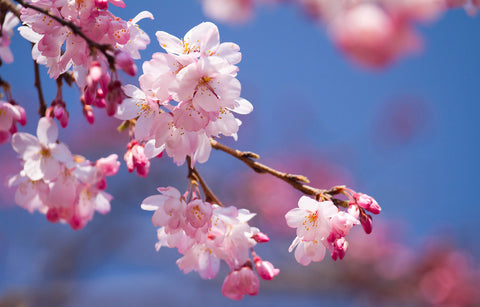
In other countries, cherry blossoms are nothing but beautiful pink flowers that smell nice and only last for a few weeks before withering away. But to any Japanese person in touch with their culture, cherry blossoms, or sakura, are symbols of life, beauty, and inevitable mortality. Sakura symbolism can be found throughout the history of the country.
During the Edo Period, cherry blossoms were considered important samurai symbols. The samurai were an ancient caste of noble warriors native to Japan. Their moral code centered around discipline, respect, and honor. But being a samurai meant that your life would be as short as that of the sakura blossom. These flowers symbolized the death of a samurai warrior and reminded other warriors to live their lives to the fullest, according to their moral code.
During World War II, sakura had slightly darker symbolism. Kamikaze pilots, famous for their suicide missions in honor of Japan, would mark their planes with the flower, a foreboding of their inevitable deaths during these missions.
Before the calendar came to Japan, ancestors relied on cherry blossoms to announce the start of planting season for a variety of crops, especially rice. That and the fact that “sa” refers to the god of rice paddies and “kura” translates to pedestal (the god’s pedestal) meant that sakura was associated with agricultural reproduction.
The Best Time for Cherry Blossom Viewing

Japan’s cherry blossom season covers the entire springtime, which is typically from mid March to May every year. If you’re planning a hanami party to catch the peak bloom, you should schedule it between the last week of March and the middle of April. People who tend to cherry blossoms always monitor the buds for a flash of pink. Once spotted, they expect a full bloom within 20 days. However, you probably don’t have sakura blossoms growing in your garden. To predict their bloom, look out for cherry blossom forecasts from reliable sources.
Key Predictions from Japan Meteorological Agency’s Cherry Blossom 2024 Forecast
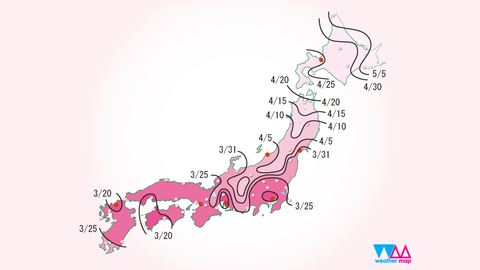
The Japan Meteorological Agency (JMA) releases official cherry blossom forecasts several times a year. According to their 2024 forecast released on February 15, sakura will reach full bloom from March 28 to May 4 across various regions of Japan. Popular regions like Tokyo, Kyoto, and Osaka were forecast to see a full bloom on March 30, April 1, and April 2, respectively. Kochi was predicted to be the first city with a full bloom (March 28) and Sapporo was predicted to be the last (May 4). Although forecasts are never 100% accurate, those dates provide a reliable estimate for people in Japan and those planning to travel for a cherry blossom festival.
Choosing the Perfect Spot for Hanami

Parks and riverbanks make the best locations for hanami, especially those associated with temples and shrines. A little research on a location will reveal if it's a popular hanami spot. Remember to check the weather report before you head to any location for cherry blossom viewing. You don’t want to be stuck in the rain.
5 Best Hanami Spots in 2024
We asked hanami lovers to rank their favorite places to view cherry blossoms in Japan. Below is our curated list:
1. Ueno Park: A Popular Tourist Delight

Located in Tokyo, Ueno Park is one of Japan's most popular tourist attractions. It will only take you 5 minutes to get there if you walk from the Ueno station. The park boasts roughly 800 sakura trees, all of which remain in high demand every spring. Try to get there early in the morning and secure a spot because Ueno Park sees a lot of crowds during sakura season. With museums, art galleries, temples, and boat rides, Ueno Park is arguably the best place to hanami.
2. Hirosaki Castle: An Abundance of Stunning Sakura Trees and Flowers
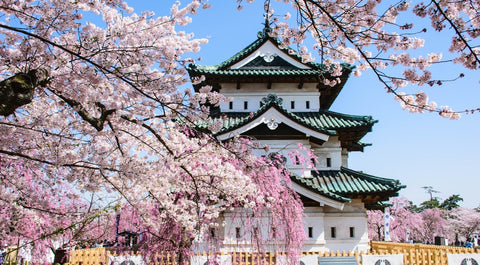
Hirosaki Castle has a park that is the most beloved hanami spot in Aomori. It’s only a 15-minute bus ride from Hirosaki Station. If you prefer to walk, you can get to the park in 30 minutes instead. There are over 2,600 sakura trees at this spot. You’ll find it extremely difficult to find a place with that many anywhere in the world. The trees around Hirosaki Castle produce about twice as many flowers as regular cherry blossom trees, thanks to a special pruning technique used by the groundskeepers. The best time to visit the castle is at night, when it and the surrounding cherry blossoms are lit up. It’s a magnificent sight!
3. Fuji Five Lakes: Beauty By The Volcanic Mountain

Near the famous Mount Fuji on Honshu Island, you’ll find a group of water bodies called the Fuji Five Lakes. The lakes are extremely popular, especially during spring, because of the mesmerizing view of Mount Fuji they offer and the beautiful cherry blossoms along their shores. If you can only visit one of the five lakes, we recommend that it be Lake Kawaguchiko. The most easily accessible of the lot, you can take a bus or train to the lake directly from Tokyo. It has roughly 300 sakura trees stretching for 1 km. Other perks of the spot include an onsen, museums, and souvenir shops.
4. Shinjuku Gyoen National Garden: Calm and Secluded Hanami
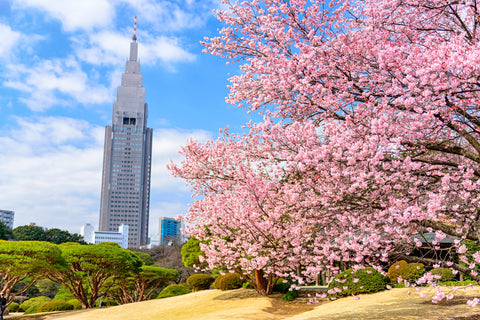
One of the most popular hanami spots in Tokyo, the Shinjuku Gyoen National Garden is easily accessible from any of three stations: Shinjuku, Shinjuku-gyoemmae, and Sendagaya. Cut your transportation time down to 10 minutes by walking from the southeast exit of Shinjuku station. Shinjuku Gyoen National Garden is famous for having cherry blossoms for several months. This is possible because of the 68 varieties of blossoming cherry trees in the garden. There is no smoking or alcohol-drinking allowed in the garden, and you may need to pay an entrance fee. These restrictions have limited the number of people there, which makes it ideal for those who don’t like crowds during hanami.
5. Sagano Romantic Train: Hanami in Motion
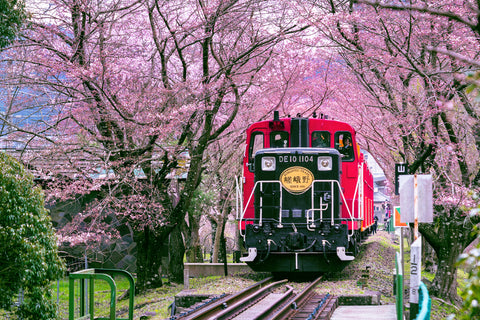
The Sagano Romantic Train offers the most unique hanami experience for many tourists. It’s a sightseeing train that runs on 19th-century railways. To get there by train, we recommend that you take one from Kyoto Station to Saga-Arashiyama Station, which is adjacent to your destination. The journey should only take about 17 minutes. A typical ride on the Sagano Romantic Train starts in Saga and ends in Kameoka. During the journey, you’ll spot a wide variety of forests, mountains, and, of course, sakura! It’s the perfect ride for you and your partner in spring.
What to Bring to a Hanami Party
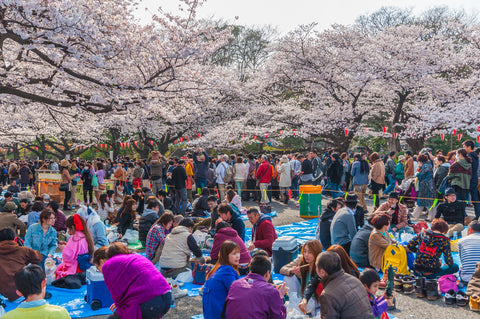
So you want to be part of a hanami party but don’t know what to bring. No worries, because we’ve got you covered. Check out our list of the essential items for a successful hanami party:
-
Hanami bento: A bento refers to Japanese-style packed lunch. Bento boxes usually have multiple compartments, one for a different traditional dish. Be sure to pack foods like tamagoyaki (Japanese omelet), sakuramochi (pink rice cake), and makizushi (sushi rolls).
-
Snacks: You should include some delicious and savory snacks and side dishes in your list. Ensure that whatever snacks you bring are authentically Japanese.
-
Disposable utensils: Bring disposable plates, cups, and chopsticks so you can use them to eat the food you bring.
-
Picnic Blanket or Sheet: We recommend a thick blanket or sheet to allow you to sit on hard surfaces. Remember that you have no guaranteed spot, so there’s no telling where you’ll sit.
-
Toilet paper and wet wipes: These are for if you have to use one of the public restrooms or to clean your hands and surfaces.
-
Garbage bags: Proper etiquette demands that you clean up after yourself when out in public places. Garbage bags make the job easier.
Traditional Foods and Drinks to Enjoy During Hanami
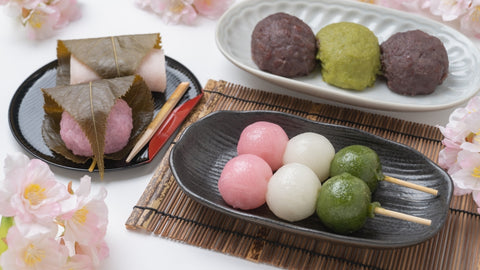
Below are traditional Japanese foods and drinks that are popular at hanami parties:
-
Sakura Mochi: Sakura mochi is one of the best traditional foods for hanami. It’s made of chewy and delicious mochi (rice cake) filled with anko (sweet red bean paste).
-
Hanami Dango: The festive hanami dango is a tri-colored sweet made specifically for the occasion. It consists of sweetened rice flour dumplings skewered on a stick.
-
Matcha and Warabi Mochi: This is a popular combo of Japanese green tea, matcha, and syrup-glazed mochi.
-
Cherry Blossom Milk Pudding: This dessert mixes cherry blossom jelly with a milk base to produce a salty and creamy pudding.
-
Sake: Sake is a popular hanami drink that has been passed down through centuries of Japanese culture. It’s an alcoholic rice wine, so make sure your hanami spot allows alcohol.
-
Traditional Japanese Snacks: Traditional snacks, candies, and sweets are an important part of hanami. The most popular ones are mochi, senbei, and matcha cookies. You’ll get a steady supply of authentic versions of these snacks if you subscribe to the Bokksu Snack Box.
Night Sakura: Cherry Blossom Viewing After Dark
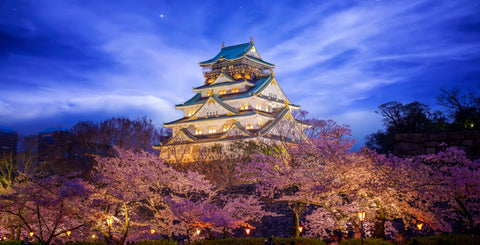
The practice of viewing cherry blossoms at night is called yozakura. Parks, riverbanks, onsens, and other spots place lanterns on branches and turn them on at night. The flowers will appear to glow. There are millions of people who prefer hanami at night. To them, it offers a magical experience unlike any other.
Etiquette and Tips for First-Time Hanami Goers
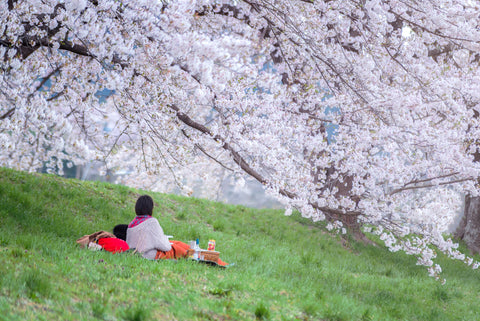
The last thing you want is to offend other people who came to experience the sakura’s beauty. Take a quick look at simple but important etiquette for cherry blossoms hanami:
-
Check the venue’s regulations on their website or brochure to see if they allow picnics, snacks, alcohol, etc.
-
When you mark a spot for your group under a cherry tree, do not take up more space than necessary or encroach on other people’s space.
-
Avoid littering public spaces, and always clean up after yourself.
-
Never touch the trees or their flowers.
-
Avoid making too much noise while viewing.
-
Always queue respectfully at the entrance to the venue or its bathrooms.
Sakura-Themed Activities and Crafts
Enhance your hanami experience with sakura-themed activities and crafts. Dancing, decorating, origami, and karaoke are great activities that engage people between cherry blossom viewings. Kids will also love to try their hands at making fun crafts. For more ideas, check out the sakura-themed items on Bokksu Boutique, such as stickers and tea sets.
Embracing the Transience of Sakura
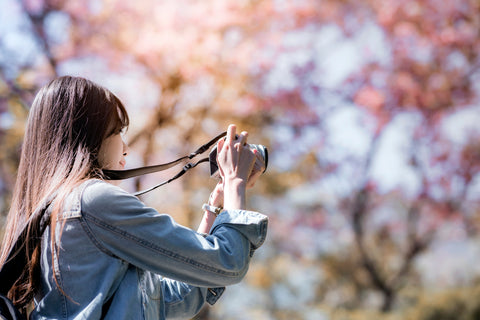
Hanami is a lot more than just viewing sakura flowers. It’s a cultural reminder of the fleeting nature of life, and why we must cherish every moment with those we love. Make the most of every hanami experience you get in your lifetime and embrace the transient beauty of the mystical sakura.
Hanami-Inspired Gifts and Souvenirs

The hanami experience is never complete without going home with something to remember. A souvenir could range from sakura-flavored snacks to cherry blossom-themed merchandise.
We have the best sakura-themed item collection coming your way in Bokksu Boutique this March 8th! From delicious snacks to memorable gift boxes, you can expect the most unique and authentic items from Japan, perfect for remembering this season.
Author Bio











